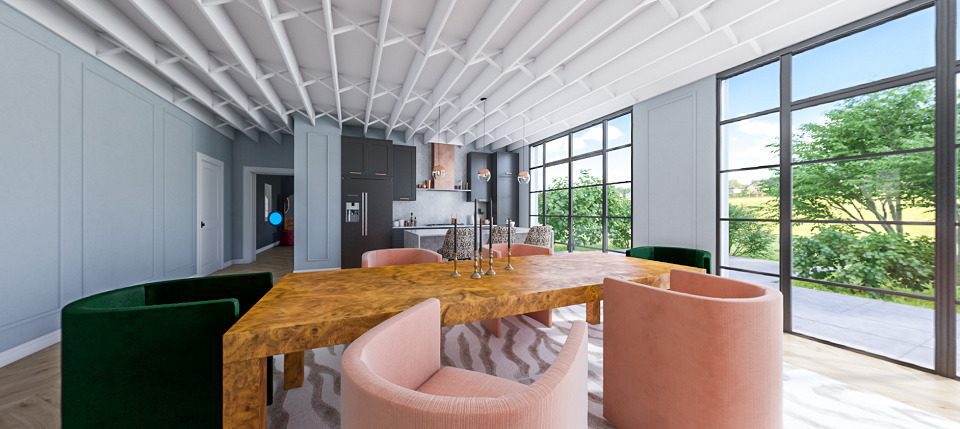Manufacturers and retailers of products that rely on touch as a selling point (think apparel, décor and furniture) have faced some of the highest hurdles erected by COVID-19. Not being able to feel a fabric’s texture or see a sofa in three dimensions can lower a buyer’s confidence level and make it that much tougher for sellers to differentiate themselves.
Executives at made-to-order furniture manufacturer Skyline Furniture were well aware of these challenges, including those created by the cancellation of trade shows where the company traditionally showcased its latest lines. Rather than bemoan the loss of in-person selling, however, Skyline Furniture went all in on 3D technology that has allowed it to create photorealistic virtual assets, which potential buyers can use for self-guided 360-degree “tours” as well as AR and VR deployments.
With the help of the self-service 3D tech platform from ALL3D, the company created four virtual apartments, complete with furniture and décor, in less than a month’s time. “It took us about three weeks from concept to finalizing the apartments, including designing the textiles, rendering the fabric to frame on the furniture, and then using the 3D tech to drop it all in,” said Meganne Wecker, President and Chief Creative Officer at Skyline Furniture in an interview with Retail TouchPoints.
Wecker already had begun her 3D journey via Cloth & Company, a business she started a few years ago with the purchase of a 3D printer. “We began to 3D model our products, and we could create photography of every fabric-to-frame configuration we offered,” she noted. “With the printer, our fabric capabilities became infinite. We couldn’t [physically] make a sample of every configuration, but when we could go to 3D, we could digitally create these fabric-to-frame images.”
Immersive Experiences Without In-Person Meetings
The technology has served as more than a stopgap substitute for attending events like Las Vegas Market. “It might have been one of our best Markets ever,” said Wecker. “With a showroom, you’re limited in what you can show. This was an immersive experience, and everybody was so excited at what they saw.”
Additionally, the ALL3D visualizations didn’t have the limitations of other virtual experiences. “I’ve experienced virtual markets for textiles, for example, and they were really clunky,” said Wecker. “We didn’t want to put people on FaceTime and make them dizzy by walking around a showroom, and we didn’t want to send people PDFs. So when we were thinking about how to bring Market to our customers, we saw it as an opportunity to reinvent ourselves.”
Skyline Furniture was able to virtually demonstrate offerings that were very much up-to-the-minute in terms of what consumers are looking for in this new everything-from-home era. “We could show how we would put a folding screen in a bedroom [to create a separate workspace] or use a dining chair at a desk,” said Wecker. “With 3D, we could put the products in an environment where they would be ‘living.’”
Ecommerce Experience Helped Skyline Adapt Quickly
Even before COVID-19, Skyline Furniture prided itself on being a tech-forward company. It has operated in the south suburbs of Chicago since its founding in 1946 and was a leader in ecommerce’s ancestor, direct mail. Many of the direct mail pioneers, including Sears, Montgomery Ward and Spiegel, also were based in the Windy City. “We became very focused on direct mail and became an important supplier to that channel,” said Wecker. “It was the same concept — made-to-order upholstery that we drop-shipped direct to the consumer. We had started selling online before it was cool to sell on the internet.”
Now, the fact that the company’s “samples” are virtual rather than physical is providing benefits to Skyline’s business model.
“3D in general gives us a lot of flexibility in terms of moving quickly to create assets and content,” said Wecker. “It’s not just speed to market, but the flexibility to pivot. If pink velvet upholstery is winning, for example, you can use that and not invest in the products that aren’t selling.
“It also gives us the ability to be exclusive for every retailer we sell to, because we’re custom manufacturers,” Wecker added. “The assortment we do for Wayfair is different from the ones we offer other retailers. Being fast and nimble is key.”
Simple, Intuitive Platform Design Expands Universe of Potential Users
The ALL3D platform also is adaptable to the technological sophistication levels of its users. “Our vision is ‘arming the 3D revolution,’” said Michael Adair, COO of ALL3D in an interview with Retail TouchPoints. “It’s a self-service, web-based platform where brands can log in and upload images, CAD and 3D models if they have them. Our system will generate a 3D model using hyper-realistic photo images, and we can generate 360-degree spins. We also have an AR version, which allows [users] to view the product in their own space.
“The platform is meant to be very simple and intuitive,” Adair added. “It’s something that someone in marketing or product management can log into and use.”
For her part, Wecker is excited by ALL3D’s range of offerings. “We see so much potential with all the content we were able to create,” she noted. “For retailers [we sell to] that aren’t interested in, or able to adopt AR/VR, we can create gorgeous lifestyle photography using the platform, or create movie-like MP4 files by sweeping the room. That’s sort of interactive, but it’s something that could live on the retailer’s own site. This has given us a really long tail in terms of content, and made us really fast and really good.”
ALL3D sees the potential for benefits in multiple parts of the buyer’s journey. “Imagine the cost savings,” said Adair. “Some of the ‘stuff’ created for these are not even a real product. That means a company could actually find out what the demand is first before they built it. Also, you don’t have to build products for samples, and you reduce your carbon footprint because you don’t have to ship the samples to an event. You also save on the cost of doing photo shoots.
“Companies have thousands of different types of fabrics, and it would be cost-prohibitive to put upholstery on all these couches,” Adair added. “This provides much more flexibility and is a much less costly way of showing off their fabrics, and it can be clicked and changed instantly.”
For Wecker, “right now feels like when ecommerce first started on the furniture retail side,” she said. “There’s a lot of hesitation to move, but COVID has fast-forwarded us so we need to get into this. Our goal is to make our offerings more accessible than they ever were before.”













